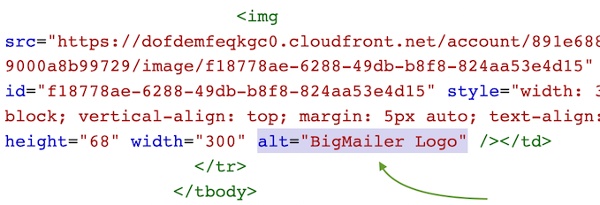Whether your organization sends email newsletters, transactional email, or on-boarding drip campaigns you probably heard of all the terms listed below. But, do you really understand what they all mean and how they can be helpful in analyzing success of your email campaigns? We break it all down and provide you with some links for additional reading.
 Alternate text or “alt text” refers to the attribute on the img tag used to load images that is used for storing a description of the image for those who can not see it. You typically see this text when the image loading is blocked by the email client. Adding descriptive alt text on every image in your email can your spam score lower and help with inboxing. (VIDEO: How to add ALT text to your HTML code.)
Alternate text or “alt text” refers to the attribute on the img tag used to load images that is used for storing a description of the image for those who can not see it. You typically see this text when the image loading is blocked by the email client. Adding descriptive alt text on every image in your email can your spam score lower and help with inboxing. (VIDEO: How to add ALT text to your HTML code.)
Brand Indicators for Message Identification (BIMI) is a new standard that makes it easier to get your logo displayed next to your message in the inbox. It is a way to verify information about your brand, similar to DKIM and SPF records. BIMI is designed to create trust, prevent fraudulent emails, and can aid deliverability.
Bounce rate in email marketing refers to the percentage of emails that were sent but not delivered. There are 2 types of bounces: 1) hard bounce, which occurs when the email doesn’t exist (possibly suspended for inactivity) 2) soft bounces, which are temporary in nature and happen for a variety of reasons – mailbox full, provider services is down, email is rejected by the mailbox provider, etc.
Insight: Some email domains have higher soft bounce rate because email shares storage with music (icloud.com, me.com, and more).
Preview text – the text that displays in your inbox. It shows you a brief preview of the email you’re about to read. Unless a custom preview text is defined (typically hidden with code), it displays the text from the first line of the email. Most bulk email marketing service providers allow you to define custom Preview text.
Pre-header – the small text that appears within the body of your email, at the very top, above your main content. In a lot of email templates, and some email marketing platforms, it is a link to the browser version of the email. So if you don’t define preview text with a custom implementation, your preview text may read, “View this email in your browser.”

Examples of bad previews in the inbox view
Delivery Rate – a ratio of emails that didn’t bounce and weren’t blocked by email provider (MBP). Emails that land in Spam folder are considered to be delivered.
Inbox Placement Rate – a ratio of emails that landed in the Inbox (didn’t go to Spam/Junk or Promo (Gmail) folders) to total emails sent. Inbox placement is something marketers can control by optimizing against inboxing factors like sender reputation, engagement, email content, and subject line.
Insight: Many email marketing services will claim high deliverability, while implying delivery, but inbox placement is what most marketers care about. ESPs can NOT track or measure inboxing rates.
Open reach is the percentage of subscribers who opened at least ONE email during a set period of time. Open reach is a great indicator of list engagement and quality. Your list has good engagement if your open reach is in the 70-90% range after 3 months of sending. The longer a subscriber doesn’t open your emails the harder it will be to place into inbox, because mailbox providers like Hotmail and Gmail use relative engagement to determine if a subscriber is interested in a sender’s email. Higher open reach leads to better deliverability and inboxing. Read more about open reach.
MBP – MailBox Provider, often also referred to as ISP, any company that provides end users with an email account. The largest MBPs in North America are Gmail, Yahoo, Microsoft, AOL, and Comcast. It’s important to not forget corporate email providers with their custom setup and unique spam filters, which can make a big difference for some industries, e.g. banks or universities.
Blocked – if email is blocked, the MBP filter has determined the message or sender is suspicious and has stopped the mail (and any other volume from the sender) from going through to the recipient.
Blacklist – blacklists are lists of IP addresses that have been reported and listed as “known” sources of spam. There are public and private blacklists. Public blacklists are published and made available to the public – many times as a free service, sometimes for a fee. There are hundreds of well-known public blacklists. If your email marketing platform account is on a shared IP with other customers and the IP gets on a blacklist, your emails can get blocked. This doesn’t mean you must have a dedicated IP, although it does help to avoid this particular problem, a good provider will rotate IPs and work on getting their IPs off blacklists. Large providers tend to have “cleaner” IPs because they have resources to maintain a healthy IP list. Many providers offer dedicated IPs at extra charge, although most will only allow it on higher tier plans.
TIP: If you use dedicated IPs, consider using a blacklist monitoring service to be notified if your IP gets blacklisted.
Bounces – a bounce means that the message cannot be accepted by the MBP (MailBox Provider) and is the email equivalent of “return to sender.” There are two types of bounces: hard and soft. Hard bounces indicate an email address is invalid or no longer exists; soft bounces indicate a temporary reason, such as a full inbox or attachment too large, for returning the message, with auto-responder (out of office) being the most common reason for a soft bounce.
Double opt-in – a practice to ask email subscribers to verify their subscription by clicking on a link in a verification email automatically sent out once a user subscribes. Double opt-in can significantly limit marketing opportunities for a given list while slightly improving list quality. Single opt-in is considered a superior subscription process by many marketers because it maximizes list growth and overall performance by minimizing signup barriers and opportunities for errors. Chad White from Litmus on advantages of single opt-in.
Re-permissioning – a practice to reach out to existing list subscribers to obtain a confirmation of permission to send emails. This has been discussed a lot lately due to GDPR’s requirement to have an explicit consent from subscribers. From what we had seen and heard, few companies had engaged in this practice, especially for US-based subscribers since GDPR scope is limited to customers located in EU, although it is recommended by experts at ReturnPath.
Relative engagement – an email subscriber engagement with the email from your sending domain relative to all other sources of email in their inbox. This inbox placement factor is the reason why the same email may go to both Inbox and Spam folder for recipients on the same campaign. So a good sender reputation may not be enough to guarantee inbox placement. Read more on improving your email deliverability and inbox placement.
Spam traps are email addresses that monitor email communications to identify spammers and senders with incorrect contact management practices. Spam traps look like legitimate email addresses, but they aren’t operated by real users. These email addresses can end up on mailing lists that are harvested from web pages, purchased/rented, or simply not properly maintained (unengaged users are not removed from list on ongoing basis). Read more about how to identify and remove spam traps from your list.
View Time Optimization (VTO) is a new email marketing service offered by Verizon Media, that owns Yahoo and AOL, that automatically times emails from companies to arrive the moment a user is logging into their (Yahoo or AOL) email, so it sits at the very top as a new message. Verizon Media claims x4 improvement in open rates and x2 in click rates. Email senders have to be approved for using the service and have to pay for it.
Return-path is a hidden email header that indicates where and how bounced emails will be processed. This header, sometimes referred to as a bounce address or reverse path, is an SMTP address that is different from your original sending address, and is used for collecting and processing of bounced messages.
utm parameters – these are URL parameters that are used to help identify the source of traffic (e.g. social networks, email and display advertising campaigns) in Google Analytics with names that start with utm_ (e.g. utm_medium, utm_source, utm_campaign). Some email marketing software providers automatically add some utm_ parameters, like utm_medium=email and some providers allow defining additional parameters in a freeform field, either globally for an account or on a per campaign basis. Read more about email campaign tracking with Google Analytics.
Did you learn something new from reading this post? Are there any other terms you think we should add to this list? Please let us know by leaving a comment, we appreciate any feedback.

